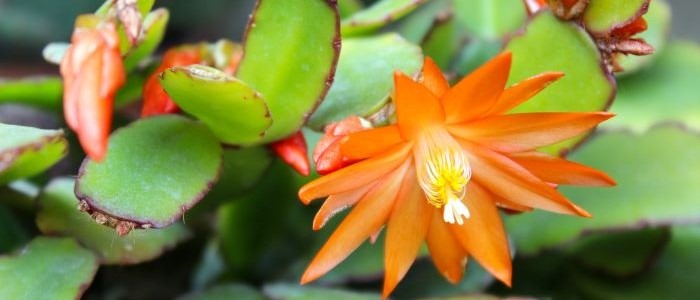When it comes to choosing the right Thanksgiving Cactus, (Schlumbergera), there are a few things to keep in mind. First and foremost, consider the size of the pot. If you’re looking for a large plant, you’ll want to select one with an appropriately sized container. On the other hand, if you’re looking for a smaller plant to place on your windowsill or desk, look for one that will fit in its pot without having to be repotted too soon.
Next, make sure to choose a plant with vibrant colors and an overall healthy appearance. While it is possible to revive sickly plants, selecting one that has been well taken care of can save you time and energy in the long run. When selecting your Thanksgiving Cactus it is also important to understand the different varieties available and decide which one best fits your needs.
There are several different species of Thanksgiving Cactus such as Schlumbergera truncata, Schlumbergera bridgesii, and Schlumbergera opuntioides – each with their own unique characteristics and care requirements. Be sure to research each variety before making your decision so that you can provide it with proper care once you bring it home.
Finally, be sure to check for any pests or disease before purchasing your cactus as these can spread quickly once brought home. Look closely at both sides of each leaf for any signs of pests or disease as well as any discoloration that might suggest stress from incorrect environmental conditions or improper nutrition levels.
By considering these factors when selecting a Thanksgiving Cactus, readers can be confident they will have chosen the right plant for them and their environment – giving them years of enjoyment!

The Thanksgiving Cactus Frequently Asked Questions
Does the thanksgiving cactus prefer sun or shade?
The Thanksgiving cactus prefers bright but indirect sunlight, making it ideal for placing near a window with filtered light. While it can tolerate some shade, too much shade may hinder its blooming potential. It is important to strike a balance between providing enough light for the plant to thrive and avoiding direct sunlight, which can scorch the leaves.
What is the best propagation method for the Thanksgiving cactus?
Stem cuttings are the best propagation method when trying to reproduce the Thanksgiving cactus. To propagate, simply take a healthy stem cutting, around 3–4 inches long, and allow it to dry for a day or two. Then, plant the cutting in well-draining soil and keep it slightly moist until roots begin to form.
Planting and potting the Thanksgiving cactus
Planting and potting a Thanksgiving Cactus is one of the most important steps in ensuring a healthy and vibrant plant. The right pot can make a world of difference! When selecting a pot, it is essential to choose one with drainage holes so that excess water can be released.
Adding a layer of gravel or pebbles at the bottom of the pot will also help with drainage, as it allows air to circulate around the roots. After choosing an appropriate pot, fill it with cacti and succulent-specific soil. This type of soil is specially formulated for plants that need fast-draining soil and plenty of aeration.
Once you have filled your pot with soil, create a small hole in the center using your finger or a spoon. Carefully place your Thanksgiving Cactus into this hole before filling the remaining space with soil until it is level with the top of the pot. Make sure not to press down on the soil too hard, as this could cause damage to your plant’s roots.
Now that you have planted and potted your Thanksgiving Cactus, all that’s left to do is water it! Watering frequency will depend on several factors such as temperature, humidity levels, size of container and amount of sunlight received by plant – however generally speaking; water when the top inch or two (2 – 5 cm)of soil feels dry to touch. Doing so will ensure that your Thanksgiving Cactus has enough moisture without getting overwatered.
With these tips in mind, readers should be well-equipped to successfully plant and care for their Thanksgiving Cactus!
Watering and feeding your Thanksgiving cactus
Watering and feeding your Thanksgiving cactus is essential for keeping it healthy and vibrant. To start, the most important factor when watering a Thanksgiving cactus is to ensure that the soil is well draining. If the soil retains too much moisture, it can lead to root rot and other problems. When it comes to watering, aim to do it every 7-10 days in the summer and cut back to every two weeks in the winter.
When it comes to fertilizing, this should be done a few times during the growing season with a balanced fertilizer such as 10-10-10 or 20-20-20. It’s important not to overfertilize as this can cause burning of the roots or foliage. Additionally, make sure that you don’t feed your plant during winter dormancy as this could cause damage or shock.
Finally, when it comes to providing light for your Thanksgiving cactus, make sure that you give them bright but indirect sunlight for optimal growth. Place them near a window that gets plenty of afternoon sun but avoid direct sunlight at all costs as this can cause scorching of leaves and flowers. You can also supplement natural light with artificial grow lights if necessary.
By following these guidelines on watering and feeding your Thanksgiving cactus, you will be able to keep your plant happy and healthy for many years!
Controlling temperature and humidity for your Thanksgiving cactus
Controlling temperature and humidity is essential for successful Thanksgiving cactus care. The ideal temperature range for a Thanksgiving cactus is between 65-80 degrees Fahrenheit, while the desired relative humidity range should be between 40-50%. If these levels are too low or too high, you can adjust them by using a humidifier or dehumidifier, respectively.
To ensure that your Thanksgiving cactus is kept in the best environment possible, it’s important to measure and monitor the temperature and humidity levels around it. A hygrometer is a great tool for this purpose; it will help you keep track of exactly how much moisture is in the air so that you can make adjustments as necessary.
Finally, if temperatures drop below 55 degrees Fahrenheit for an extended period of time, your plant may go into dormancy. During this time, you should reduce watering and fertilizing until warmer temperatures return. This will help protect your plant from any winter damage due to cold weather.
By following these guidelines and monitoring the temperature and humidity of their Thanksgiving cactus’ environment with a hygrometer, readers will be able to successfully keep their plants healthy and happy for many years to come!
Pruning, propagating, and re-potting your Thanksgiving cactus
Pruning, propagating, and re-potting your Thanksgiving cactus are important steps to ensure that it will remain healthy and happy for many years. Pruning should be done with a sharp pair of scissors or pruners at an angle to avoid damaging the plant. To propagate a Thanksgiving cactus, take cuttings from the top of the plant and use rooting hormone to encourage new roots to form.
When repotting your Thanksgiving cactus, it is important to use a well-draining potting mix and select a pot that is only one or two inches larger than the current pot. Repotting should be done in spring or summer when temperatures are warm enough for the cactus to adjust properly. After repotting, place your Thanksgiving cactus in an area with bright indirect light. With these tips, readers can prune, propagate, and re-pot their Thanksgiving Cactus for many years of enjoyment.
In addition to pruning, propagating, and re-potting your Thanksgiving Cactus successfully, it is also important to be aware of common pests such as mealybugs and spider mites. These pests can cause damage if left unchecked so it’s important to monitor them closely by regularly inspecting leaves for any signs of infestation such as discolored spots or webbing.
If there is an infestation present then contact insecticides specifically formulated for use on cacti should be used according to label directions. By following these guidelines readers will have no trouble keeping their plants healthy and pest-free.
Common Pest and The Thanksgiving Cactus
Caring for a Thanksgiving Cactus can be tricky, especially when it comes to managing common pests. Aphids, mealybugs, and spider mites are the most frequent offenders that can cause significant damage if left untreated. To help mitigate these risks, proper drainage must be implemented by using a pot with holes and avoiding standing water accumulation.
Additionally, providing bright but indirect sunlight is also beneficial as its natural repellent properties will help keep pests away. If you have access to a hygrometer device, monitoring temperature and humidity levels in the vicinity of your cactus is also recommended in order to identify any changes which could signal an infestation.
In cases where pest control measures still need to be taken, there are various options available such as insecticides or natural remedies like garlic or pepper sprays. Whatever method you choose, make sure to follow all instructions carefully in order to protect yourself and ensure optimal results. With these tips in mind and regular maintenance of your Thanksgiving Cactus you’ll be able to enjoy its beauty for many years without worrying about any pesky intruders!
Conclusion
The Final Thoughts section of this article will emphasize the joy and pride that comes with caring for a Thanksgiving Cactus. Growing a living thing requires patience, love, and attention – something to be thankful for. It is also important to remember that it takes time for the cactus to grow and flower.
The section should also encourage readers to share their tips and advice with other Thanksgiving Cactus growers. This can be done through gardening forums, blogs, or social media platforms. Taking pictures of the plant’s progress can also be a great way to look back on the journey, as well as provide potential growers with ideas and inspiration.
Finally, this section should remind readers to appreciate the beauty and grace of their Thanksgiving Cactus. Watching it bloom is a wonderful thing – one that brings peace and joy into our lives. Taking care of a living thing teaches us about responsibility, resilience, and love – something we can all be thankful for!
Other House Plants With Orange Flowers













